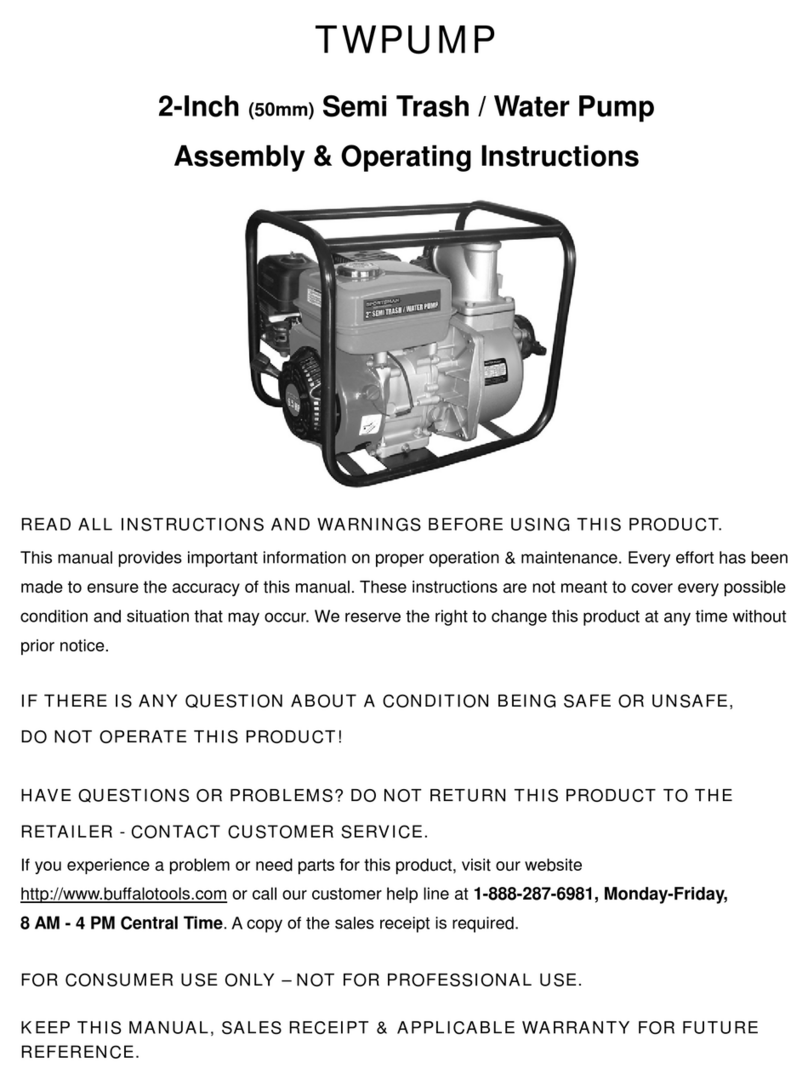
TWP365 3-Inch (76.2mm) Gasoline Trash/Water Pump Assembly And Operating Instructions 8
STARTING THE GASOLINE WATER PUMP
To start this Gasoline Water Pump:
1. Confirm that Oil has been properly added.
2. Confirm that Gas has been properly added.
3. Turn the fuel valve to the “on” position.
4. Move the choke lever to the “closed” position.
5. Set the engine switch to the “on” position. (Figure 3)
6. Slowly pull on the recoil starter handle until a slight resistance is felt. Then pull briskly to start the
engine.
7. Gently return the cord into the Gasoline Water Pump to avoid damage to the starter or housing.
Never allow the cord to snap back.
8. If the engine fails to start, repeat step 6. NOTE:After repeated attempts to start the engine, consult
the troubleshooting guide before attempting again. If problems persist, call 1-888-287-6981,
Monday - Friday, 8 AM - 4 PM Central Time.
9. Once the engine has started and runs for about a minute, move the choke lever approximately half
way towards the “open” position. Wait an additional 30 seconds and then move the choke lever
completely over to the “open” position.
10. Allow this Gasoline Water Pump to run for several minutes before beginning the project.
BREAK-IN PERIOD
Breaking in an engine of any size is important to the life of the engine. The first twenty hours of operation is
considered the break-in period for this Gasoline Water Pump. For best results and an engine with fewer
problems, it is suggested that you:
• Avoid heavy loads during the first twenty hours.
• Not run the engine at its highest speeds for extended periods.
• Change the engine oil after ten hours of operation during the break-in period only.
OPERATION
Wear eye and hearing protection when using this Gasoline Water Pump.
Moisture can condense in a unit, so it is extremely important to drain the tank after each use. If left
in the tank, moisture could cause rust and weaken the tank.
PRIMING THE GASOLINE WATER PUMP
For best results, this Gasoline Water Pump must be primed before use. Priming
forces air out of the pump allowing it to pump water more efficiently. To prime:
1. Place the Gasoline Water Pump on a solid, level surface as close to the
water source as possible.
2. Remove the Priming Plug (A, Figure 3)
3. Fill the Gasoline Water Pump with water by filling through the opening.
4. Replace the Priming Plug.
5. Start the Gasoline Water Pump engine.
6. Partially restrict the discharge hose to improve priming.
7. The Gasoline Water Pump is now primed and ready for use.
A
Figure 3





























